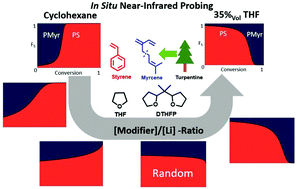The effect of THF and the chelating modifier DTHFP on the copolymerisation of β-myrcene and styrene: kinetics, microstructures, morphologies, and mechanical properties†‡
Abstract
The statistical anionic copolymerisation of the biobased monomer β-myrcene with styrene in cyclohexane was investigated via in situ near-infrared (NIR) spectroscopy, focusing on the influence of the modifiers (i.e., Lewis bases) tetrahydrofuran (THF) and 2,2-di(2-tetrahydrofuryl)propane (DTHFP) on the reactivity ratios. With increasing [modifier]/[Li] ratio, the reactivity ratios in the system myrcene/styrene are adjustable from rS ≪ rMyrvia rS ≈ rMyr to rS ≫ rMyr. The bidentate modifier DTHFP affects the reactivity ratios much more than THF: minute amounts only (0.35 equivalent relative to Li) are required to randomize the copolymer, and one equivalent to invert the reactivity ratios. Using these reactivity ratios, copolymer composition profiles are obtained, which upon increasing the modifier concentration vary from tapered, block-like copolymers to random to inversely tapered copolymers. 1H-NMR spectroscopy was used to determine the microstructure of the myrcene units in the copolymers. With increasing [modifier]/[Li] ratio, the content of 1,4-units decreases and the content of 3,4- and 1,2-units increases. DTHFP as a modifier minimizes the content of 1,2-units. The glass transition temperatures also depend on the [modifier]/[Li] ratio, but less strongly than in the copolymer poly(styrene-co-isoprene). Although all copolymers have the same composition (33%mol myrcene, corresponding to 39.6%weight and 45%vol), very similar molecular weights (about 90 kg mol−1) and low dispersities (1.06 to 1.10), different morphologies could be obtained. Lamellar, cylindrical and gyroid structures were identified by TEM and SAXS measurements. The mechanical properties vary in a wide range from hard and brittle to soft and flexible. The gyroid structure showed the highest Young's modulus and no viscoelastic deformation.

- This article is part of the themed collection: Synthetic Methodologies for Complex Macromolecular Structures


 Please wait while we load your content...
Please wait while we load your content...